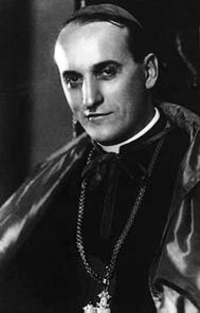Aloysius Stepinac Cleric
Aloysius Viktor Stepinac (Croatian: Alojzije Viktor Stepinac, 8 May 1898 –10 February 1960) was a Croatian Catholic cardinal and Archbishop of Zagreb from 1937 to 1960. In 1998 he was declared a martyr and beatified by John Paul II'>Pope John Paul II.Stepinac was ordained on October 26, 1930 by archbishop Giuseppe Palica, and in 1931 he became a parish curate in Zagreb. He established the archdiocesan branch of Caritas in 1931, and was appointed coadjutor to the see of Zagreb in 1934. When Archbishop Anton Bauer died on December 7, 1937, Stepinac succeeded him as the Archbishop of Zagreb. During World War II, on 6 April 1941, Yugoslavia was invaded by Nazi Germany, who established the Ustaše-led Independent State of Croatia (Croatian: Nezavisna Država Hrvatska, NDH). As archbishop of the puppet state's capital, Stepinac had close associations with the Ustaše leaders during the Nazi occupation, had issued proclamations celebrating the NDH, and welcomed the Ustaše leaders. Despite initially welcoming the Independent State of Croatia, Stepinac subsequently condemned the Nazi-aligned state's atrocities against Jews and Serbs. He objected to the persecution of Jews and Nazi laws, helped Jews and others to escape and criticized Ustaše atrocities in front of Zagreb Cathedral in 1943.After the war he publicly condemned the new Yugoslav government and its actions during World War II, especially for murders of priests by Communist militants. Yugoslav authorities indicted the archbishop on multiple counts of war crimes and collaboration with the enemy during wartime. The trial was depicted in the West as a typical communist "show trial", biased against the archbishop; however, some claim the trial was "carried out with proper legal procedure". In a verdict that polarized public opinion both in Yugoslavia and beyond, the Yugoslav authorities found him guilty on the charge of high treason (for collaboration with the fascist Ustaše regime), as well as complicity in the forced conversions of Orthodox Serbs to Catholicism. He was sentenced to 16 years in prison, but was released to house arrest after five, with his movements confined to his home parish of Krašić.After foreign and domestic pressure, Stepinac was released from Lepoglava prison. In 1952 he was appointed cardinal by Pope Pius XII. He was unable to participate in the 1958 conclave. Stepinac died of polycythemia in 1960 while still under confinement in his parish. On October 3, 1998, John Paul II'>Pope John Paul II declared him a martyr and beatified him before 500,000 Croatians in Marija Bistrica near Zagreb.Stella Alexander, author of The Triple Myth, a sympathetic biography of Stepinac, writes about him that "Two things stand out. He feared Communism above all (especially above fascism); and he found it hard to grasp that anything beyond the boundaries of Croatia, always excepting the Holy See, was quite real. ... He lived in the midst of apocalyptic events, bearing responsibilities which he had not sought. ... In the end one is left feeling that he was not quite great enough for his role. Given his limitations he behaved very well, certainly much better than most of his own people, and he grew in spiritual stature during the course of his long ordeal."
Search
Cardinal
| From | 1938 |
|---|---|
| To | 1960 |
Aloysius Stepinac on Wikipedia
External resources
- http://www.cardinalstepinacvillage.com
- http://www.catholic-forum.com/saints/sainta66.htm
- http://www.croatianhistory.net/etf/jews.html
- http://www.glas-koncila.hr/index.php?option=com_content&view=article&id=119&Itemid=122
- http://www.hartford-hwp.com/archives/62/123.html
- http://www.hic.hr/books/stepinac/english/index.htm
- http://www.hr/darko/etf/stepinac.html
